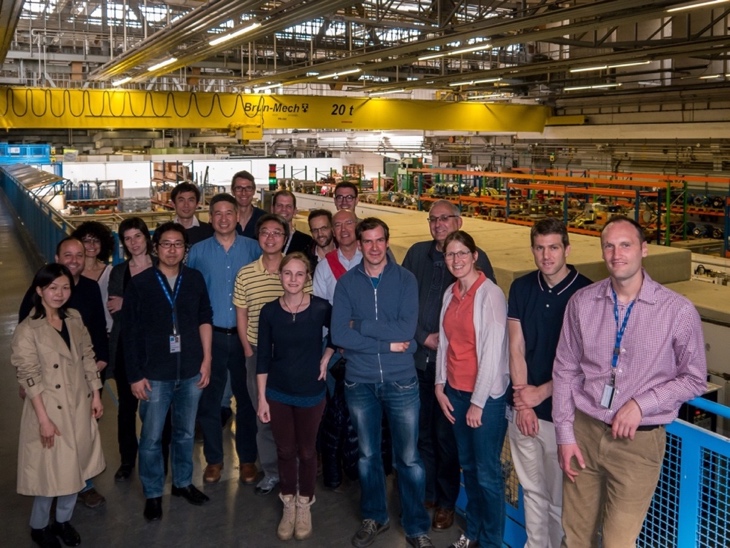The discovery promises to help physicists understand the nature of the universe’s most abundant particle.
FASER Collaboration [1] at CERN has for the first time detected subatomic particles called neutrinos created by a particle collider [2], as announced by the collaboration on March 19, 2023. The discovery promises to deepen scientists’ understanding of the nature of neutrinos, first spotted in 1956, which are the most abundant particle in the cosmos and a key participant in the process that makes stars burn. The work could also shed light on cosmic neutrinos that travel large distances and collide with the Earth, providing a window on distant parts of the cosmos. Tsinghua University has made long term contributions to FASER detector design, construction and operation, and Tsinghua has also directly contributed to this discovery.
“We’ve discovered neutrinos from a brand new source, from particle colliders, where you have two beams of particles smashing together at extremely high energy to make the neutrinos,” said Jonathan Feng, Co-Spokesperson of the FASER Collaboration and particle physicist at UC Irvine who initiated the project, which now includes over 80 researchers at 22 partner institutions [3].
“Neutrinos are particles that we know exist,” said Jamie Boyd, a particle physicist at CERN and a Co-Spokesperson of FASER alongside Feng. “They’ve been known for several decades, and were very important for establishing the standard model of particle physics. But previously, no neutrino produced at a collider had ever been detected by an experiment.”
Qing Wang, director of the Center for High Energy Physics and professor of the Department of Physics at Tsinghua University, said: "The production and detection of this ghost particle at the highest frontier of energy has opened up new territory for basic science. ”
“The collider neutrinos that were detected by FASER this time are in an energy regime between that of fixed target experiments and cosmic neutrinos, and are muon neutrinos from CC interactions. It opened a door for understanding the mechanism of neutrino productions, the proton behavior in small-x regions, and the forward detector physics. In the future, we expect FASER to detect neutrinos of other types, as well as provide clues to potential new physics signatures such as sterile neutrinos and dark matter particles.” said Xin Chen, Team Leader of the Tsinghua FASER group and associate professor of the Department of Physics at Tsinghua University.

Fig 1. Collier neutrino events detected by FASER
Since the discovery of neutrinos in 1956, the majority of neutrinos studied by physicists have been low-energy neutrinos. But the neutrinos detected by FASER are the highest energy ever produced in a lab, and are similar to the neutrinos found when deep-space particles trigger dramatic particle showers in our atmosphere. “They can tell us about deep space that we can’t learn in other ways,” said Boyd. “These very high-energy neutrinos in the LHC are important for understanding really exciting observations in particle astrophysics.”
It’s the latest result to come from the Forward Search Experiment (FASER), a particle detector designed and built by an international group of physicists and installed at the European Council for Nuclear Research (CERN) in Geneva, Switzerland. There, FASER detects particles that are produced by CERN’s Large Hadron Collider (LHC). FASER itself is brand-new and unique among particle-detecting experiments. Compared to other detectors at CERN like ATLAS or CMS, which are several stories tall and weigh thousands of tons, FASER is only about one ton and fits neatly into a small side-tunnel at CERN. That, and it took only a few years to design and construct, using spare parts from other experiments. FASER𝜈 is a project to study collider neutrinos at TeV energies, which detected the first high-energy neutrino candidates at the LHC in 2021 [4].
“Neutrinos are the only known particles that the much larger experiments at LHC are unable to directly detect, so FASER’s successful observation means the collider’s full physics potential is finally being exploited,” said UC Irvine professor and experimental physicist Dave Casper.
Beyond neutrinos, one of FASER’s other chief objectives is to help identify the particles that make up dark matter, which physicists think comprises most of the matter in the universe, but which they’ve never directly observed before. FASER has yet to find signs of dark matter, but with the LHC set to begin a new round of particle collisions in a few months, the detector stands ready to record them, should they appear.
“Tsinghua joined FASER in 2019 in the early days of the collaboration. During the past 4 years, Tsinghua physicists, postdocs, and students have made continuous contributions to FASER and FASER𝜈 detector R&D and simulation studies, and Tsinghua has also made direct contributions to these first physics results using real LHC data,” said Feng.

Fig 2. Tsinghua joined the first FASER Collaboration Meeting [5]
“The Tsinghua group has made leading contributions to the first FASER physics results, both through their work on the FASER tracking detector and on the neutrino analysis. The tracker, a crucial component for the new results, is an area where Tsinghua has been heavily involved in the hardware, commissioning, calibrations and operations. Tsinghua members, especially Tomohiro, have also actively worked on the emulsion neutrino analysis where first collider neutrino events have been presented,” said Boyd.

Fig 3. Shuimu Tsinghua Scholar Tomohiro Inada worked on the emulsion detector installation and commissioning at FASER
On March 5, 2019, the FASER experiment was officially approved by CERN, and Xin Chen and Zhen Hu, associate professors of the Center for High Energy Physics of Tsinghua University and the Department of Physics of Tsinghua University, joined the FASER Collaboration. The team undertook a number of work such as tracker detector R&D, emulsion detector R&D, and data analysis.
Tomohiro Inada, a postdoctoral fellow in the team and Shuimu Tsinghua Scholar, has made direct contributions to the discovery of collider neutrinos due to his works on the trackers commissioning, operation and data analysis. The collaboration has submitted an article “First Direct Observation of Collider Neutrinos with FASER at the LHC” to arXiv [6] and Phys. Rev. Lett. on March 24.
Di Wang, a 2020 master's student in the Department of Physics, worked on the design, construction and integration of multiple electronics modules of the tracker, as published in Nucl. Instrum. Methods Phys. Res. A in 2022 [7]. 2019 doctoral students Jinfeng Liu and Hao Pang also actively participated in the shifts and maintenance of the detector. These works have been supported by the National Natural Science Foundation of China and the Tsinghua University Initiative Scientific Research Program. [8]
[1] https://faser.web.cern.ch/
[2] https://home.cern/news/news/experiments/new-lhc-experiments-enter-uncharted-territory
[3] https://news.uci.edu/2023/03/20/uc-irvine-led-team-is-first-to-detect-neutrinos-made-by-particle-collider/
[4] “First neutrino interaction candidates at the LHC”, https://doi.org/10.1103/PhysRevD.104.L091101
[5] https://www.phys.tsinghua.edu.cn/info/1053/4115.htm
[6] https://arxiv.org/abs/2303.14185
[7] “The tracking detector of the FASER experiment”, https://doi.org/10.1016/j.nima.2022.166825
[8] /info/1175/102463.htm
Editor: Li Han

